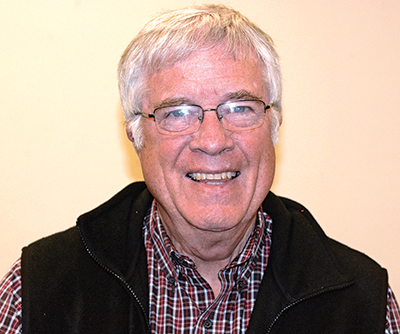Turkey Creek retail bonanza
Part 1: laying the groundwork
 Jim Nixon
Jim Nixon
Going back to when Turkey Creek’s roughly 360-acre area was essentially barren in the mid-1980s, “There was a tract of land that was owned by a fellow named Goodman, a wealthy developer from Florida right outside of Orlando. Mr. Goodman had purchased this in an auction from the FDIC in 1986 when the Butcher banks failed,” said Jim Nixon, a licensed broker/representative with First Commercial Real Estate and an investor with Turkey Creek/Farragut Land Partners, which ignited the Turkey Creek retail explosion.
“Mr. Goodman had attempted to do some developments there, had talked to the City of Knoxville and the Town of Farragut and various tenants about going on this piece of property,” Nixon added. “He was either unable or unwilling to do what it took to bring that development together.”
Foundations: 40 Years of Farragut
Jim Nixon, a licensed broker/representative with First Commercial Real Estate and an investor with Turkey Creek/Farragut Land Partners, also has contributed his talents to help Town of Farragut. A member of Farragut Business Alliance/Shop Farragut who is highly respected for his knowledge and negotiating skills going back decades, Nixon has served as a consultant with Town officials concerning real estate matters. This weeks Foundations: 40 Years of Farragut podcast is presented by .
Enter John Turley
“By 1994 or 1995, there was quite a bit of interest in that property, and Mr. Goodman had failed to make any concrete transaction on it,” he said.
Enter John Turley, prominent real estate mogul with First Commercial Real Estate who was principal partner in Turkey Creek Land Partners.
“John Turley knew a prospect for a portion of (the 360 acres),” Nixon said. “He approached the Goodmans, and they said they would sell it all — but not a part of it.
“… John Turley placed it under a contract to purchase,” he added about the 360 acres. “And thereupon, he raised the capital to be able to purchase it, and it was purchased in, I’m going to say February, of 1995.”
The final price tag, which was paid “in cash, was a little over $7 million,” Nixon said.
More acreage
Meanwhile, the development would grow roughly 40 acres “to a little over 400 acres” when purchasing the property of “a prominent physician, a doctor in Farragut named Dr. Duncan, whose home was behind part of our property,” he said. “It’s where the current Tennova (Healthcare Turkey Creek Medical Center) sits.”
Lots of negotiations
After Turley’s purchase on behalf of Turkey Creek Land Partners, “We began a development conversation with Farragut, conversation with the City of Knoxville, we negotiated with the wetlands people, we negotiated with the State of Tennessee for improvements to Lovell Road,” Nixon said.
“At that time the Lovell Road Interstate crossing for Lovell Road wasn’t even wide enough for two trucks to pass on it,” he added. “It was in gross disrepair (compared to) modern standards.”
Parkside Drive
As for plans to build Parkside Drive through the development, from North Campbell Station Road to Lovell Road, “We negotiated with the City of Knoxville, the Town of Farragut and Knox County,” Nixon said. “Those improvements were, eventually, a joint public-private partnership, in which Turkey Creek Land Partners contributed the land where the road went, and 100 percent of the engineering funds for designing the road. … There was about a half-million dollars worth of engineering.”
As for direct Parkside Drive construction costs, “Knox County put an amount in and City of Knoxville put an amount in,” he said. “Farragut, at that time, did not choose to contribute.”
Road construction began “in the late 90s,” Nixon said.
However, because building Parkside Drive all the way to Lovell Road would involve crossing a wetland area, an uphill battle would begin for the Partners.
Wetland issues
Having a few dozen acres within the development designated as wetland, which are located in its northeast corner, in the late 1990s “we began negotiations with the 10 various agencies having to do with wetlands,” Nixon said. “We had TDEC, Tennessee Department of Environment & Conservation, the EPA, (Tennessee Wildlife Resources Agency), TVA — all of these agencies (had) different requirements for the wetland before we could even build the road into the property. Knox County and City of Knoxville wanted all of those complete before they constructed the road.”
Meanwhile, Nixon said there was “great animosity from some of the people who didn’t want us to cross the wetland. They demonstrated onsite, climbed up on derricks and posted signs that said, ‘Don’t cross the wetland.’ Demonstrated on TV.”
At a public hearing on the wetland at Knoxville West High School “on whether we were going to get permission to build that road across the wetland … there were, like, 200 people that appeared,” Nixon said.
After about “a couple of years … we ended up getting permission to build that road — and in the process we dedicated 58 acres of the wetland to be preserved in perpetuity and put a conservation easement on it, which says nobody can ever touch it or build on it or convert it to (commercial) use,” he said.
Although realizing Turley, himself and the other Turkey Creek Land Partners would have to deal with the wetland issue, “We certainly weren’t aware that we were going to meet this type of opposition,” Nixon said. “Or that it would be such an enormous venture to obtain the permits we needed to cross the wetland.”In fact, “The improvements that we made had to be monitored and completed and inspected for five years,” Nixon said about the wetland.
A walking trail, which connects the wetland with the commercial area westward into Farragut, became one of its added features.
In fact, “It’s part of the Farragut trail system,” Nixon said.
Overall, “It was difficult and it was very expensive, but we’re very happy that we did it,” he said about the wetland issue. “We had really good partners who were patient with us and worked with us to obtain the things that we needed to obtain.”
(Read about the retail development of Turkey Creek in Part 2, featured on next’s week’s Foundations 29 page)


